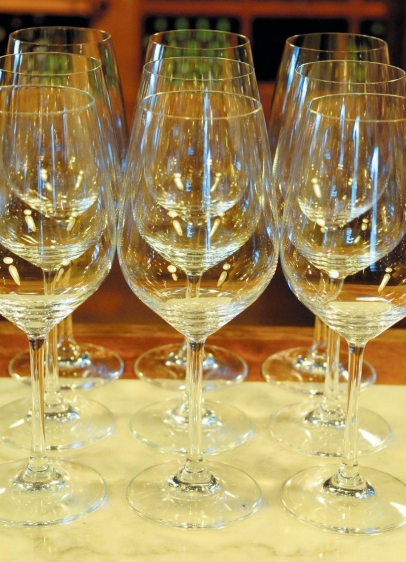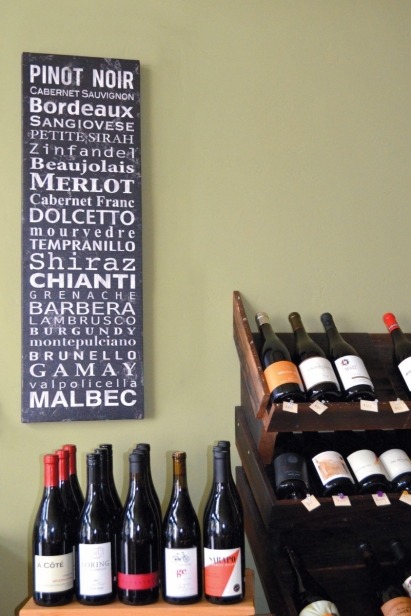Wine Pairing Perfection
What I love most about wine are the friendships formed and memories made while consuming this fermented grape juice beverage. I recently had a cozy evening with friends in an industrial park off Rice Road in Oxnard. That might seem like an odd statement; however, I was at the Tuscan-inspired tasting room of Magnavino Cellars, sitting on leather sofas in front of a fireplace, tasting wine while we waited for a pizza to be delivered.
As our group chatted about wine and travel experiences, owner and winemaker Robert Wagner mentioned the numerous awards his wines won in the 2014 San Francisco Chronicle Wine Competition.
Excited to share, Robert poured from the many wines on the table. His wife, Barbara, was beside him, her lap a bed for their dog Coco.
As a sommelier, I taste wine often and try to find magical pairings that elevate the food and wine experience. I learned all the "wine pairing rules" long ago; however, the process of pairing has become so automatic that now I start imagining pairings whenever I taste a wine.
A friend pressed me to explain wine pairing rules as I tasted Magnavino Cellars' wines and created my imaginary pairings. I started with my main rules: Pair to preparation, not protein. Match the weight of the food to the weight, or body, of the wine. (See "WEIGHT LIFTER" further below for the sommelier definition of weight.) This is followed by the tastes (sweet, salty, sour, bitter, umami), then the flavors (cherry, blackberry, citrus, rosemary etc.)
Once the preparation and weight are determined, I either match tastes – sour (acid or tartness) with sour, sweet with sweet (a sugary sweet wine with residual sugar like a late-harvest riesling or a porto with a sweet dessert, for example). Note that fruity flavors in wine often are perceived as sweetness when the wine is actually dry.
Or I use contrasting tastes – sweet with sour, and sweet with salty.
Lastly, I match flavors that are complementary, sometimes using the flavors in a sauce as a bridge to marry flavors.
Barbecue was the first thing that came to mind as I tasted Magnavino's 2010 Old Vine Zinfandel, a medium-body, medium-acid wine with pronounced red fruit flavors, soft tannins, spice and a hint of sweet oak. (Zinfandel and barbecue are a classic match.)
The wine's medium weight would pair well with any medium-weight protein, and its fruitiness would match a barbecue sauce's sweetness. Plus, the acid in the wine pairs with the acid in the barbecue sauce.
Unless you like your food fiery, I add a cautionary rule that "alcohol fuels the flame" with a spicy sauce. High-alcohol wines amplify capsaicin's burning sensation. Better to use the rule that "cool and sweet beat the heat," meaning low-alcohol, high-acid and sweeter-style wines like riesling or gewürztraminer are best for spicy, hot food.
Why it works:
• The wine and barbecue sauce both have a tang.
• Complementary fruity flavors.
• Smoke and oak – when there is smoke, bring on the oak.
When I tasted the Magnavino 2010 Sangiovese, I noticed medium alcohol, bright acidity, fleshy cherry fruit flavors, a hint of earth and subtle tannins. This wine would pair really well with a roasted game bird, wild boar, a rich chicken dish, mushroom ravioli or anything with tomato sauce.
Why it works:
• The wine and food are both medium-weight.
• The wine and tomato sauce both have a bright acidity.
• Mushrooms and the wine both feature earthy flavors.
The 2010 Tuscan Romance won first place in the people's choice award at the Ventura County Wine Trail's Food and Wine Challenge earlier this year. (They partnered with Café Zack in Ventura, which served filet mignon with a peppercorn crust and brandy crème reduction.)
This wine is Robert's take on a super Tuscan blend, which combines the lighter sangiovese with cabernet and merlot. It creates a heavier wine, and the addition of the thicker-skinned grape varieties adds tannin. Acid and tannin are great for cutting though fat in rich dishes. I immediately imagined a pairing with a heavier, rich dish like braised beef cheeks or osso buco.
Why it works:
• Heavier food calls for heavier wine.
• Tannin and acid cut fatty richness.
Magnavino's San Francisco Chronicle award– winning 2010 Petite Sirah is jammy and fullbodied. This wine has lush dark fruity flavors of blueberries and blackberries with a lot of supporting tannins. Robert jumped in with his imaginary pairing: "I would pair this wine with a juicy steak, perhaps a rib eye with a blueberry reduction sauce." I wholeheartedly agree.
Why it works:
• Heavier food calls for heavier wine.
• Black fruit flavors in the wine mirror the blueberry sauce, creating a flavor bridge to the meat.
• Tannin cuts fat.
Someone said the pizza had arrived. We popped open the cardboard box, brought out the paper napkins and started noshing on pizza. Filling our glasses with our favorite wines of the night, we made a toast.
This brings me to a final rule for a perfect pairing: Drink what you like, eat what you like and do it among friends.
If you have questions, send an email to info@edibleventuracounty.com.
WEIGHT LIFTER
The idea of food and wine "weight" can be confusing because I'm not referring to the common cooking definition associated with ounces and pounds. In the wine world, weight refers to how the food or wine comes across to your palate and is often referred to as "body."
When conducting my educational wine tours, I ask my guests to think of milk products: Skim is light, 2% is medium and whole milk is heavy.
All of them taste like milk, but they have a different mouthfeel depending on the fat content (skim milk will feel lighter, for example). In wine, weight largely is determined by alcohol content, amount of tannin and whether it has been aged in oak. In general, pinot noir wines are considered light-bodied; merlot, medium; and cabernet sauvignon, heavy.
When it comes to food, how a dish is prepared – poached, baked, boiled, braised, fried, roasted, sautéed or sauced – is much more important to me than the protein being used because the preparation changes the flavors and weight of the food.
For example, poached halibut is lighter than pan-seared halibut with a rich cream sauce. When pairing the dishes with wine, the lighter-weight pinot grigio with citrus flavors would be a good match for the poached halibut, while a buttery chardonnay would be ideal for the heavier, sauced halibut.
LISA STOLL'S TOP 11
Keep this handy guide of quick, easy-to-remember rules for picking a wine to go with dinner.
Matchmakers
• Match the wine to the preparation, not the protein (grilled, baked, sautéed, poached, etc.).
• Match the weight of the food with the weight of the wine. (Lighter food, lighter wine; and heavier food, heavier wine.)
• Match preparation and weight first, taste second and flavors third.
Tastes
• Acid loves acid, and sweet loves sweet.
• Sweet beats the heat, and alcohol fuels the flame.
• Salt loves sweet wines and also boosts acid, but can make bitter wine taste more bitter.
• Acid and tannin fight fat.
• A tannic wine is softened by fat.
Flavors
• Choose either complementing or contrasting flavors.
• Create a flavor bridge using wine flavors and sauce flavors.
• When there is smoke, bring on the oak.
Bonus Rules
• Pull a lot of corks.
• Taste wine at every opportunity, even if you think you won't like it.
• If the wine is open and food is on the table, it's a match.
• Eat and drink what you like and don't worry about the rules.





